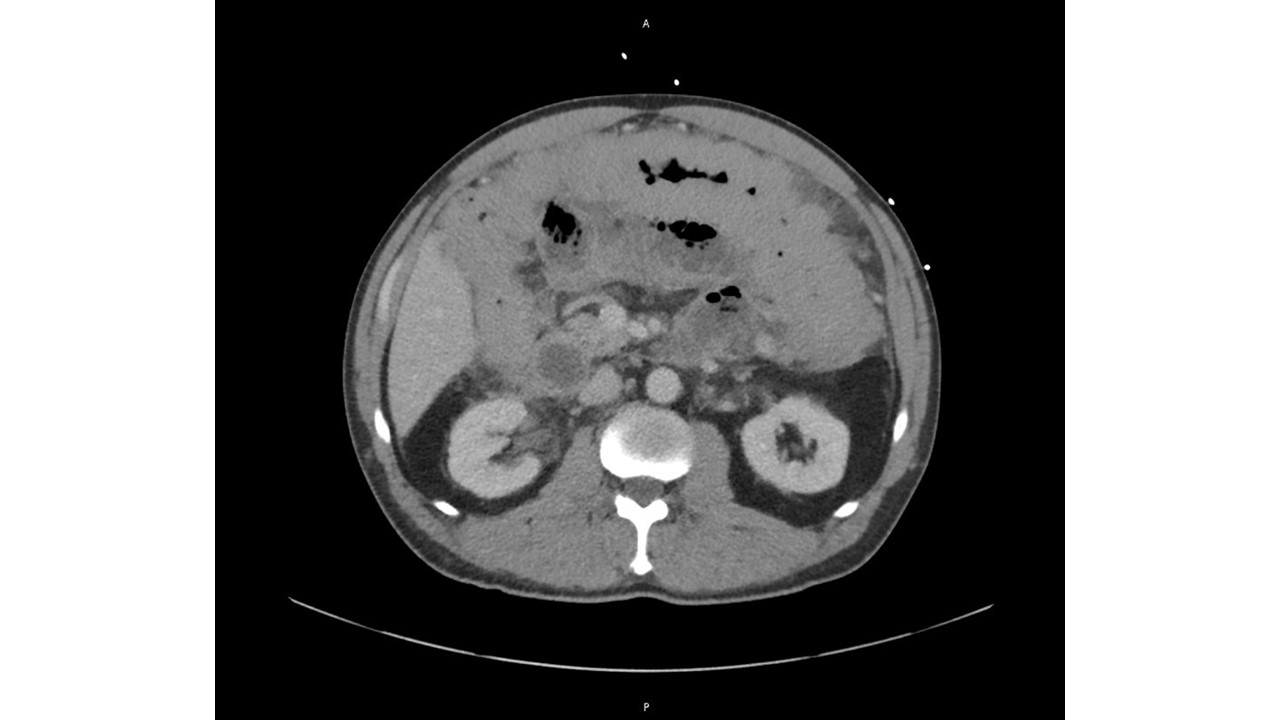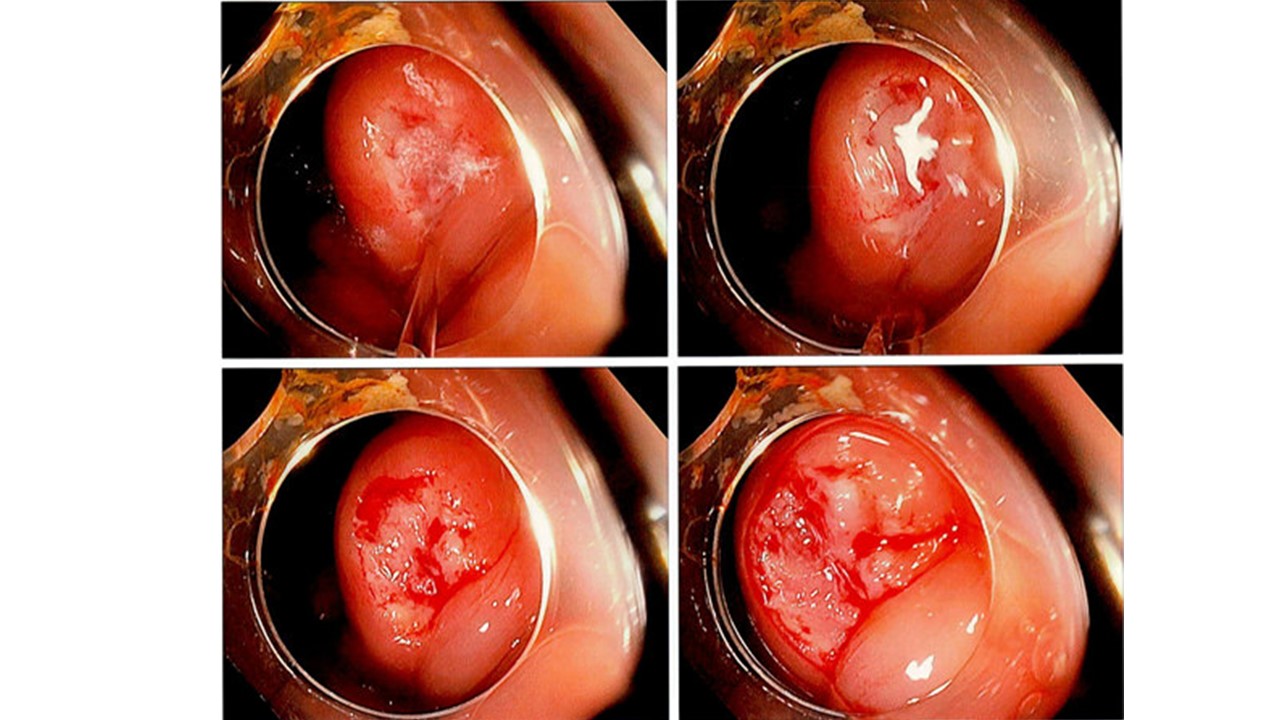Monday Poster Session
Category: Colon
P2515 - A Rare Case of Primary Colorectal Lymphoma: Extra-Nodal Diffuse Large B-cell Lymphoma
Monday, October 27, 2025
10:30 AM - 4:00 PM PDT
Location: Exhibit Hall

Nisar Amin, MD
Charleston Area Medical Center
Charleston, WV
Presenting Author(s)
Nisar Amin, MD, Tiana Dodd, DO, Omar Elfeky, MD, Harleen Chela, MD, Ebubekir Daglilar, MD
Charleston Area Medical Center, Charleston, WV
Introduction: Primary colorectal lymphoma is a rare malignancy, accounting for only 0.2–0.6% of all colorectal cancers. It typically occurs in older adults (mean age 55–70 years) and presents with nonspecific symptoms such as abdominal pain, weight loss, and occasionally a palpable mass
Case Description/
Methods: A 56-year-old male with a history of atrial fibrillation on digoxin and a family history of lymphoma presented with a two-month history of dull, periumbilical abdominal pain, worsening over the past two weeks (8/10 intensity). He reported loose, non-bloody stools for one week without overt diarrhea, as well as possible night sweats and a transient urticarial rash on his back and flank. He denied fever, recent weight loss, or lymphadenopathy. A prior outpatient CT abdomen showed colonic wall thickening; he was empirically treated for colitis with no improvement. On presentation, he was hemodynamically stable with mild diffuse abdominal tenderness. Labs were unremarkable aside from elevated CRP (16.3); ESR,CBC, calprotectin, and infectious workup were unremarkable. Repeat CT abdomen revealed extensive colonic wall thickening (Figure-1), and CT chest showed lymphadenopathy above and below the diaphragm.
Colonoscopy performed which revealed a large mass in the transverse colon (Figure-2) with colonic mucosal biopsies demonstrated increased intraepithelial lymphocytes. Immunohistochemistry and FISH confirmed a diagnosis of high-grade diffuse large B-cell lymphoma. The patient started outpatient R-CHOP chemotherapy under oncology care.
Discussion: The colon is the least common site of gastrointestinal lymphoma, following the stomach and small intestine. At the time of diagnosis, involvement of additional organs and lymph nodes is frequently observed, making the definition of primary extranodal lymphoma controversial. A more liberal definition considers cases in which the extranodal site is the predominant clinical manifestation, suggesting a likely extranodal origin of the non-Hodgkin lymphoma (NHL). Survival rates are similar for nodal and extranodal NHL, though extranodal NHL tends to have better disease-free survival. Risk factors for primary gastrointestinal NHL include immunodeficiency, immunosuppressive therapy, and autoimmune conditions like inflammatory bowel disease and celiac disease. Common symptoms—abdominal pain, weight loss, and a palpable mass—are nonspecific, often leading to delayed diagnosis. Early endoscopic and imaging evaluation is crucial for patients unresponsive to initial treatment.

Figure: Figure-1. Cross section of the CT of abdomen demonstrating extensive colonic wall thickening.

Figure: Figure-2. Polypoid edematous colonic mucosa transverse colon to sigmoid colon on colonoscopy.
Disclosures:
Nisar Amin indicated no relevant financial relationships.
Tiana Dodd indicated no relevant financial relationships.
Omar Elfeky indicated no relevant financial relationships.
Harleen Chela indicated no relevant financial relationships.
Ebubekir Daglilar indicated no relevant financial relationships.
Nisar Amin, MD, Tiana Dodd, DO, Omar Elfeky, MD, Harleen Chela, MD, Ebubekir Daglilar, MD. P2515 - A Rare Case of Primary Colorectal Lymphoma: Extra-Nodal Diffuse Large B-cell Lymphoma, ACG 2025 Annual Scientific Meeting Abstracts. Phoenix, AZ: American College of Gastroenterology.
Charleston Area Medical Center, Charleston, WV
Introduction: Primary colorectal lymphoma is a rare malignancy, accounting for only 0.2–0.6% of all colorectal cancers. It typically occurs in older adults (mean age 55–70 years) and presents with nonspecific symptoms such as abdominal pain, weight loss, and occasionally a palpable mass
Case Description/
Methods: A 56-year-old male with a history of atrial fibrillation on digoxin and a family history of lymphoma presented with a two-month history of dull, periumbilical abdominal pain, worsening over the past two weeks (8/10 intensity). He reported loose, non-bloody stools for one week without overt diarrhea, as well as possible night sweats and a transient urticarial rash on his back and flank. He denied fever, recent weight loss, or lymphadenopathy. A prior outpatient CT abdomen showed colonic wall thickening; he was empirically treated for colitis with no improvement. On presentation, he was hemodynamically stable with mild diffuse abdominal tenderness. Labs were unremarkable aside from elevated CRP (16.3); ESR,CBC, calprotectin, and infectious workup were unremarkable. Repeat CT abdomen revealed extensive colonic wall thickening (Figure-1), and CT chest showed lymphadenopathy above and below the diaphragm.
Colonoscopy performed which revealed a large mass in the transverse colon (Figure-2) with colonic mucosal biopsies demonstrated increased intraepithelial lymphocytes. Immunohistochemistry and FISH confirmed a diagnosis of high-grade diffuse large B-cell lymphoma. The patient started outpatient R-CHOP chemotherapy under oncology care.
Discussion: The colon is the least common site of gastrointestinal lymphoma, following the stomach and small intestine. At the time of diagnosis, involvement of additional organs and lymph nodes is frequently observed, making the definition of primary extranodal lymphoma controversial. A more liberal definition considers cases in which the extranodal site is the predominant clinical manifestation, suggesting a likely extranodal origin of the non-Hodgkin lymphoma (NHL). Survival rates are similar for nodal and extranodal NHL, though extranodal NHL tends to have better disease-free survival. Risk factors for primary gastrointestinal NHL include immunodeficiency, immunosuppressive therapy, and autoimmune conditions like inflammatory bowel disease and celiac disease. Common symptoms—abdominal pain, weight loss, and a palpable mass—are nonspecific, often leading to delayed diagnosis. Early endoscopic and imaging evaluation is crucial for patients unresponsive to initial treatment.

Figure: Figure-1. Cross section of the CT of abdomen demonstrating extensive colonic wall thickening.

Figure: Figure-2. Polypoid edematous colonic mucosa transverse colon to sigmoid colon on colonoscopy.
Disclosures:
Nisar Amin indicated no relevant financial relationships.
Tiana Dodd indicated no relevant financial relationships.
Omar Elfeky indicated no relevant financial relationships.
Harleen Chela indicated no relevant financial relationships.
Ebubekir Daglilar indicated no relevant financial relationships.
Nisar Amin, MD, Tiana Dodd, DO, Omar Elfeky, MD, Harleen Chela, MD, Ebubekir Daglilar, MD. P2515 - A Rare Case of Primary Colorectal Lymphoma: Extra-Nodal Diffuse Large B-cell Lymphoma, ACG 2025 Annual Scientific Meeting Abstracts. Phoenix, AZ: American College of Gastroenterology.
